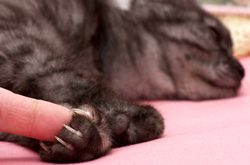 Is your cat continuously missing the litter box? Does he no longer play, or perhaps bite inappropriately? If you answered yes to these questions, and your furry feline friend is declawed you will want to continue reading on, and learn the truth behind the barbaric and nonsensical practice. Between the behavioral problems and health issues that crop up, declawing your cat could be the worst thing you could do to him.
Is your cat continuously missing the litter box? Does he no longer play, or perhaps bite inappropriately? If you answered yes to these questions, and your furry feline friend is declawed you will want to continue reading on, and learn the truth behind the barbaric and nonsensical practice. Between the behavioral problems and health issues that crop up, declawing your cat could be the worst thing you could do to him.
What Is Declawing?
Pet owners justify the declawing of their cat in an effort to curb unwanted scratching of furniture, people, and other pets. Maybe your kitten has begun climbing your curtains or shredding the arm of your couch. Sometimes they will even take their scratching behaviors to the corners of the walls in your home. Declawing is one way to stop anymore damage being done, but is only the beginning of damaging your cat for the rest of his life.
Declawing a cat is the surgical act of amputating your pet’s fingers at the last knuckle, removing his toes and therefore his balance. While on a human this may pose only minimal consequences outside of re-learning how to pick up items and other simple tasks, your cat’s nails are connected directly to his bones and are retractable. The snipping of the toes is not just making him re-learn how to walk but also causes substantial damage to the tendons in his paws. This means a lot of pain, more strain on his paws, legs, shoulders and back as well as the on set of behavioral problems from such a major change in his life.
Behavioral problems crop up when the cat no longer has use of his claws or is suffering too much pain to continue on with proper potty habits. His inability to protect himself or grab items during play can bring about frustrations that cause biting – far worse than a cat scratch. His paws may also hurt, from the strain of not having proper balance and ligament formation that he no longer feels comfortable on litter in the litter box. The litter itself may cause pain, or the act of covering up his waste may hurt too much for him to bother with. He may start going potty outside of the litter box.
Infection, regrowth of the nail in an abnormal way, shattered bones and more are all risks and high probabilities with this surgery. Just like any other surgery, there are other standard risks such as anesthesia risks and the strain on the body to go through surgery to begin with. Is saving your furniture from claw marks worth mutilating your best friend? What if there were alternative solutions?
Alternatives to Declawing
There are alternative options to this surgery that can protect your furniture, home and family from your kitty’s claws. The first is to make sure your cat has a proper place to perform his scratching behaviors, such as a play gym, kitty furniture or cat tree. These can be found in pet stores, online and even many department stores at an affordable price. You can lure your pet to use this instead of your furniture by letting him know it belongs to him. Use some dried, fresh or liquid cat nip to heavily scent the item then show it to your cat. You can also use cat teaser toys, laser pointers or anything else your pet loves to play with on the cat furniture to help him associate it with positive and comfortable emotions.
Another option is cap your kitty’s nails. You can do this yourself or ask a professional pet groomer to do it for you. Even some veterinarians will help! A claw cap is a glove like piece of latex that safely glues onto your cat’s individual nail. Put one on each nail, and he can still grab things, rub and be comfortable without causing any damage. Many quality brands of this items exists on the pet market and can often be found in a large variety of colors, including glow in the dark or glittery! Of course, clear is available for those who love the natural look.
Educate; Don’t Amputate
Before electing to do any surgery or procedure on your pet, no matter what your vet says, educate yourself on the risks, benefits and everything that is involved from the preparation, procedure itself and after care. This is no different for declawing your cat! If you come to your vet looking for help, and they suggest declawing, educate yourself before making that final appointment that will change your cat’s life forever. It is not reversible!
Find Toys, Treats and Gifts for Your Cat at Pampered Paw Gifts